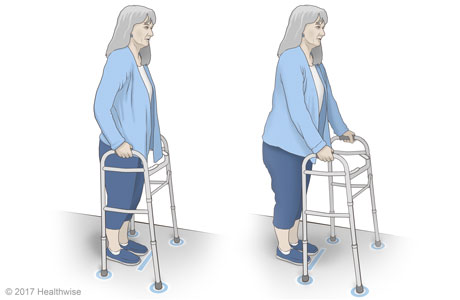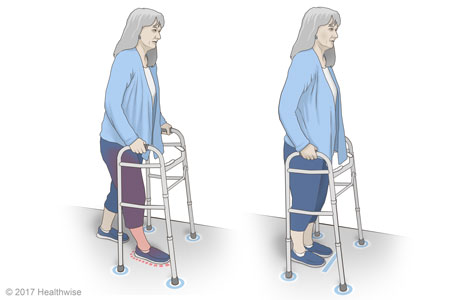Our Health Library information does not replace the advice of a doctor. Please be advised that this information is made available to assist our patients to learn more about their health. Our providers may not see and/or treat all topics found herein.
Topic Contents
Using a Walker
Overview
Using a walker can help you move with less pain and more stability. A walker can help you be more independent and safe as you do your daily activities.
Be sure your walker fits you. When you stand up in your normal posture and relax your arms at your sides, the walker's hand grips should be level with your wrists. Then, when you rest your hands on the hand grips, your elbows should be slightly bent.
Being safe
A walking aid—a walker, crutches, or a cane—helps if you have limited strength, range of motion, joint stability, coordination, or endurance. Using a walking aid can help you be more stable, safe, and independent in your daily activities. It can also reduce the stress on a painful joint or limb.
Here are some ideas to make using your walking aid easier and safer.
- While walking, look straight ahead, not down at your feet.
- Clear away small rugs, cords, or anything else that could cause you to trip, slip, or fall.
- Be very careful around pets and small children.
They can be unpredictable and get in your path when you least expect it.
- Keep the rubber tips on your walking aid clean and in good condition.
This helps prevent slipping. You can buy replacement tips from medical supply stores and drugstores. Ice tips are also available to use outdoors in winter weather.
- Avoid slick conditions or areas.
Be careful with wet floors and snowy or icy driveways. In bad weather, be especially careful on curbs and steps.
- Don't rely only on your walking aid to help you stand up or sit down.
Put one or both hands on the surface you're sitting on or on the arms of the chair as you sit down or stand up.
- Always place your walking aid where it won't fall and where you can reach it easily.
- Lead with the correct leg when you go up or down stairs or a curb.
- When you go up stairs or a curb, always use your strong or uninjured leg to take the first step.
- When you go back down, step with your weak or injured leg first.
- Remember "Up with the good, and down with the bad" to help you lead with the correct leg.
- Ask your doctor or physical therapist if it's okay to use your walking aid on the stairs.
If it is okay, have them show you how to do it correctly.
- Ask for help if you feel unsure about going up and, especially, down stairs.
How to use a walker
Put the walker in the correct position before you start to walk.

Set the walker at arm's length in front of you, with all four legs on the floor.
If your walker has wheels on the front legs, push the walker forward so it's at arm's length in front of you.
Use this pattern for walking.

Use the handles of the walker for balance as you move your weak or injured leg forward to the middle area of the walker. Don't step all the way to the front.
Push straight down on the handles of the walker as you bring your strong leg up, so it is even with your injured leg.
Repeat.
Use this pattern to go up and down a curb. The first few times you try this, have another person nearby to steady you if needed.

Stand as close to the edge as you can while keeping all four legs of the walker on the surface you're standing on.
When you have your balance, move the walker up or down to the surface you are moving to.
Push straight down on the handles for balance and to take weight off your injured leg.
If you are going up, step up with your stronger leg first, and then bring your weaker or injured leg up to meet it. If you are going down, step down with your weaker leg first, and then bring your stronger leg down to meet it. (Remember "up with the good, and down with the bad" to help you lead with the correct leg.)
Get your balance again before you start to walk.
Sit down and stand up from a chair using your body. Don't use your walker to help you sit down or stand up.

To sit, back up to the chair. Touch the back of your legs to the chair.
Support most of your weight on your strong leg, and reach back for the arms of the chair.
Slowly and carefully lower yourself into the chair.
To get out of a chair, use both hands and push against the arms of your chair. Then put both hands on your walker.
Related Information
Credits
Current as of: July 24, 2025
Author: Ignite Healthwise, LLC Staff
Clinical Review Board
All Ignite Healthwise, LLC education is reviewed by a team that includes physicians, nurses, advanced practitioners, registered dieticians, and other healthcare professionals.
Current as of: July 24, 2025
Author: Ignite Healthwise, LLC Staff
Clinical Review Board
All Ignite Healthwise, LLC education is reviewed by a team that includes physicians, nurses, advanced practitioners, registered dieticians, and other healthcare professionals.
This information does not replace the advice of a doctor. Ignite Healthwise, LLC disclaims any warranty or liability for your use of this information. Your use of this information means that you agree to the Terms of Use and Privacy Policy. Learn how we develop our content.
To learn more about Ignite Healthwise, LLC, visit webmdignite.com.
© 2024-2025 Ignite Healthwise, LLC.



